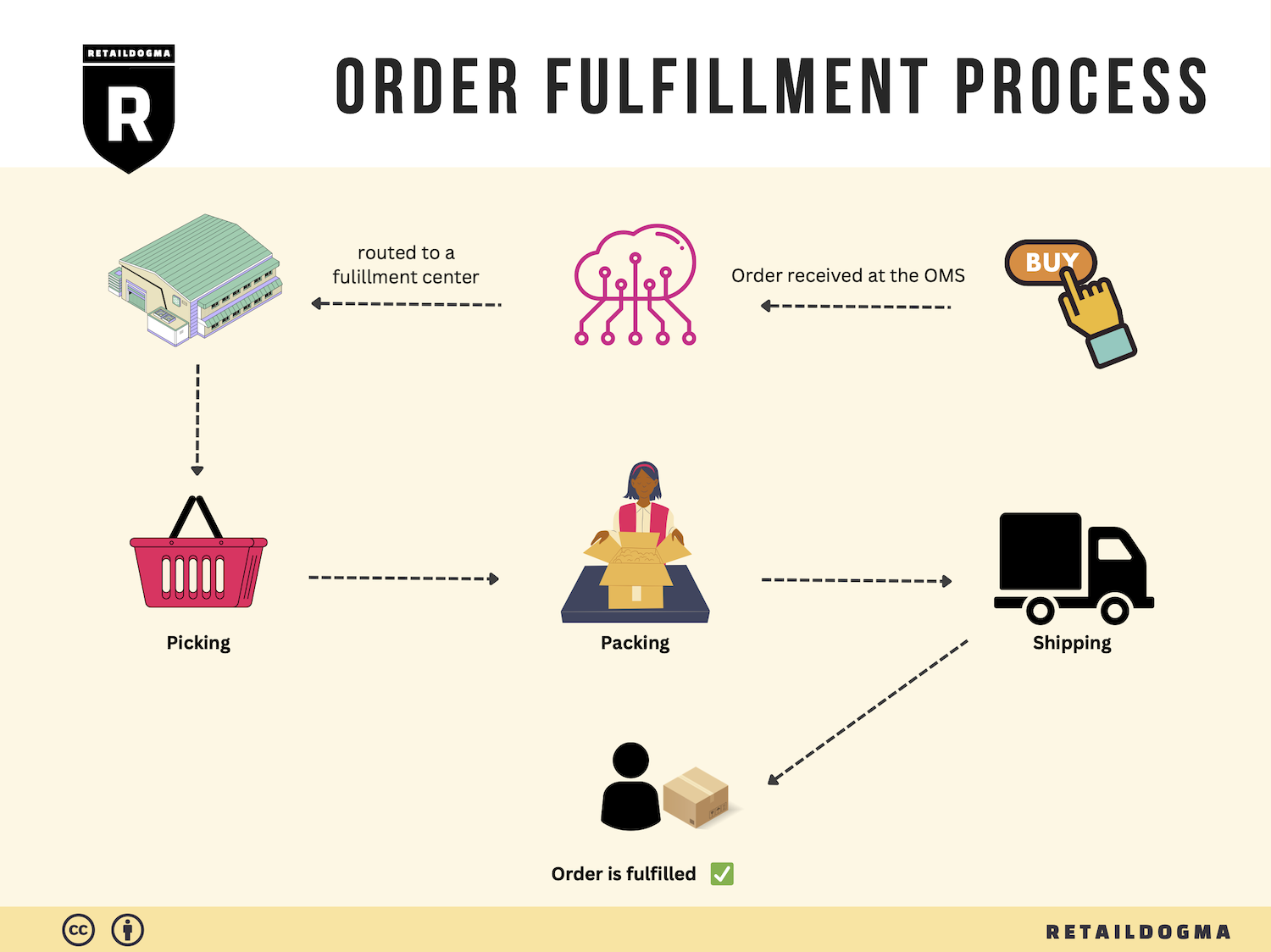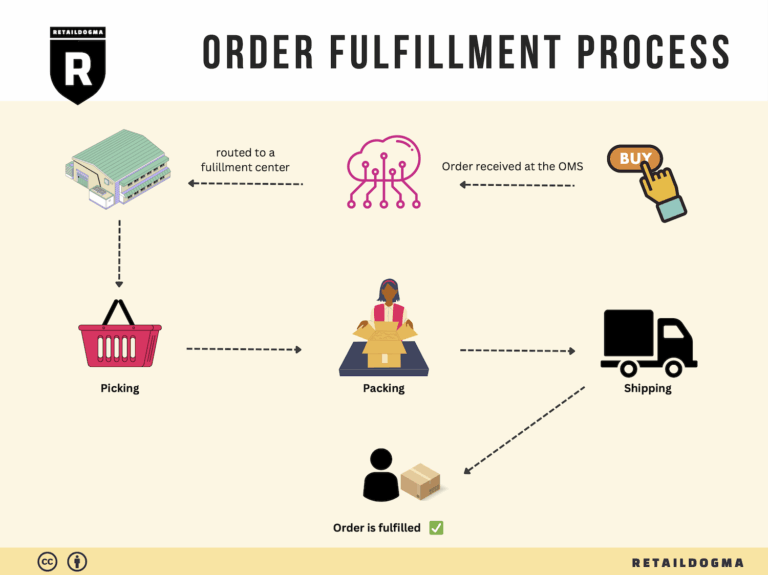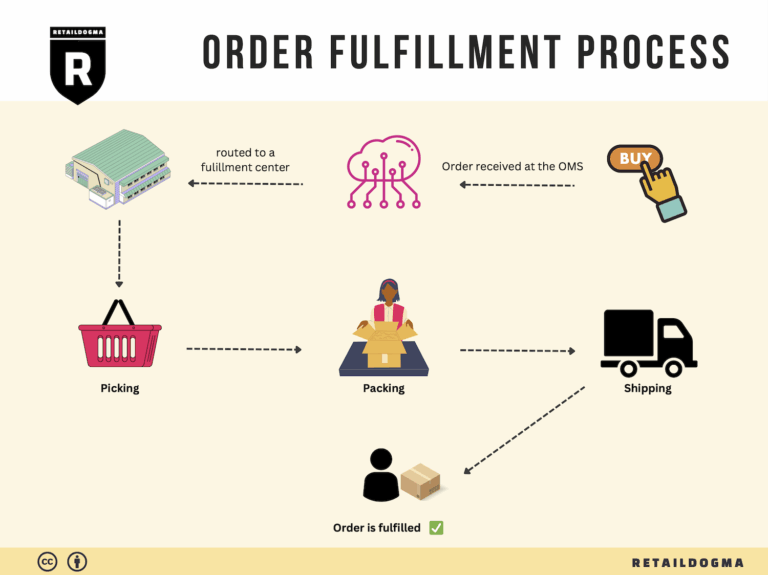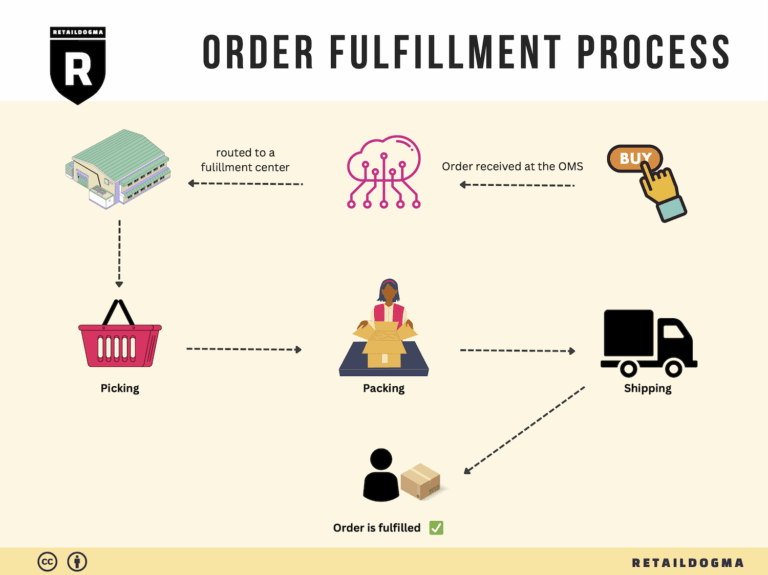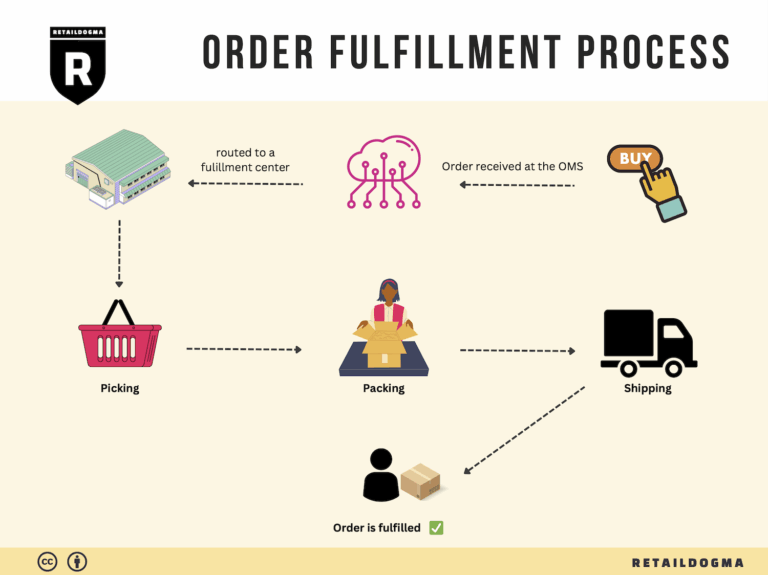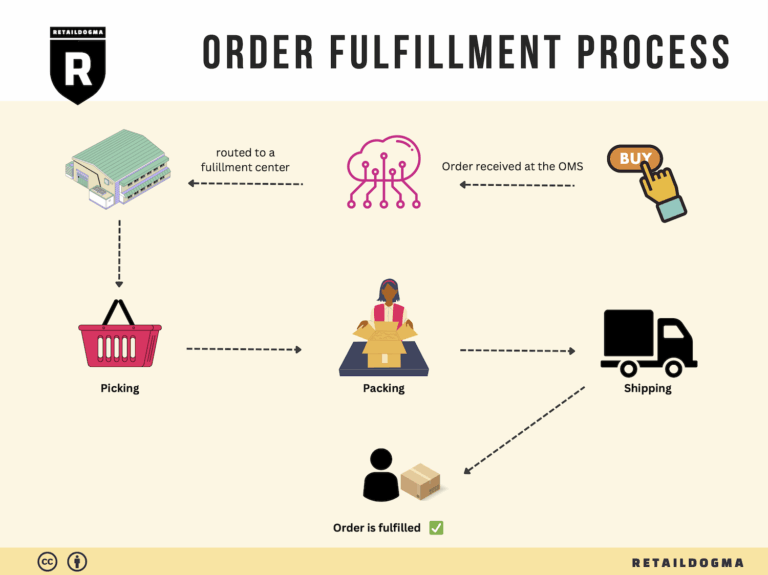How Order Fulfillment Works: A Step-by-Step Guide for Businesses
What is E-commerce Fulfillment? An Introduction for Growing Businesses
Understanding E-commerce Fulfillment
As an e-commerce business owner, you may find yourself grappling with the overwhelming task of packing and shipping orders. Managing logistics can quickly become a daunting challenge, especially as your sales grow and customer expectations rise. The process of getting a product into the hands of a customer—known as fulfillment—plays a critical role in your business’s success. It encompasses everything from inventory management and order processing to packing, shipping, and handling returns. A smooth fulfillment process is essential not only for customer satisfaction but also for maintaining your operational efficiency.
This guide aims to demystify the complexities of e-commerce fulfillment, providing you with the knowledge you need to scale your operations effectively. We will explore various fulfillment models, including Third-Party Logistics (3PL) and Fulfillment by Amazon (FBA), highlighting the advantages and disadvantages of each. Understanding these options will help you determine the best fit for your business, depending on factors like order volume, product type, and target market.
Moreover, we will delve into the core services associated with e-commerce fulfillment. This includes inventory storage, order picking and packing, shipping logistics, and return management. These services are critical for ensuring that your customers receive their products promptly and in excellent condition, which in turn fosters loyalty and repeat business.
Choosing the right fulfillment partner is another pivotal aspect we will cover. The right partner can streamline your operations, reduce costs, and enhance your customer experience. We will provide you with practical criteria to evaluate potential partners, including their technology capabilities, service offerings, and pricing structures.
Finally, pricing is a crucial consideration in your fulfillment strategy. We will break down the various cost components, such as storage fees, shipping rates, and handling charges, to help you understand how to budget effectively for your logistics needs.
The goal of this guide is to empower you to make informed decisions about your logistics and fulfillment strategies. By understanding the intricacies of e-commerce fulfillment, you can position your business for sustainable growth while ensuring that your customers enjoy a seamless shopping experience.
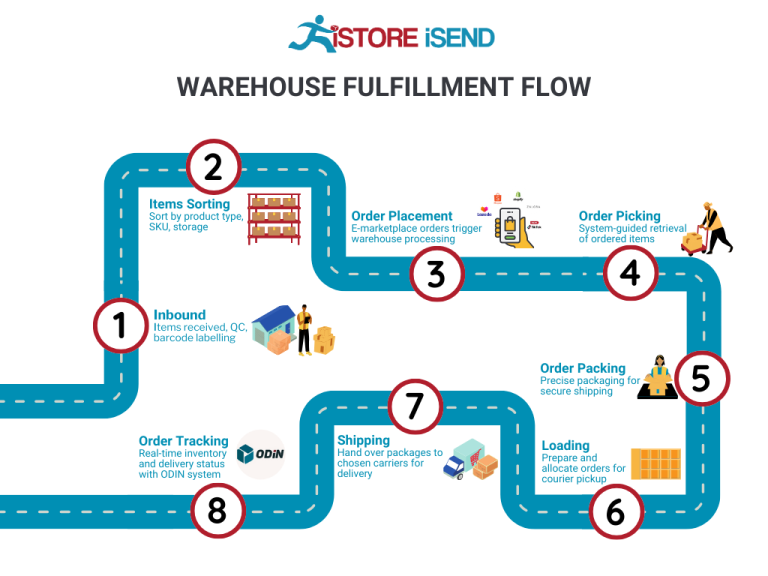
What You’ll Learn In This Guide
- What is E-commerce Fulfillment? An Introduction for Growing Businesses
- The Order Fulfillment Process: From ‘Buy’ Button to Customer’s Door
- Comparing Fulfillment Models: In-House vs. 3PL vs. Dropshipping
- A Deep Dive into Amazon FBA: Pros, Cons, and Who It’s For
- Core Services Offered by Fulfillment Centers
- How to Choose a Fulfillment Partner: A 6-Point Checklist
- Understanding Fulfillment Pricing: A Breakdown of Common Fees
- Frequently Asked Questions (FAQs) about Fulfillment
- Conclusion: Is Outsourcing Fulfillment the Right Move for Your Business?
- Important Disclaimer
The Order Fulfillment Process: From ‘Buy’ Button to Customer’s Door
1. Receiving Inventory
The first step in the order fulfillment process is receiving inventory at the fulfillment center, such as the Amazon RIC3 facility in Richmond, VA. When products arrive, they are checked against purchase orders to ensure that the correct quantities and items have been delivered. This process often utilizes unique identifiers known as SKUs (Stock Keeping Units) to track products efficiently.
Importance: Proper receiving procedures are crucial for maintaining inventory accuracy and minimizing discrepancies. Inaccurate inventory records can lead to stockouts or overstock situations, affecting customer satisfaction and operational efficiency. By implementing systematic receiving processes, businesses can ensure that their inventory levels are accurate, which is vital for effective order management and forecasting.
2. Warehouse Storage
Once inventory is received and verified, it is stored in designated locations within the warehouse. Efficient warehouse storage involves organizing products systematically, often using shelving units or pallet racks. This organization allows for easy access and retrieval when orders come in. Businesses often use warehouse management systems (WMS) to optimize storage space and manage the location of products.
Importance: Effective storage solutions not only help in maximizing warehouse space but also enhance retrieval speed during order picking. A well-organized warehouse minimizes the time taken to locate products, which is critical for meeting customer expectations for timely delivery. Furthermore, proper storage helps in maintaining product quality, especially for perishable or sensitive items.
3. Order Picking
When a customer places an order, the next step is order picking. Warehouse associates are provided with pick lists, which detail the items needed to fulfill the order. The picking process may involve various methods, including single order picking, batch picking, or zone picking, depending on the volume and complexity of orders.
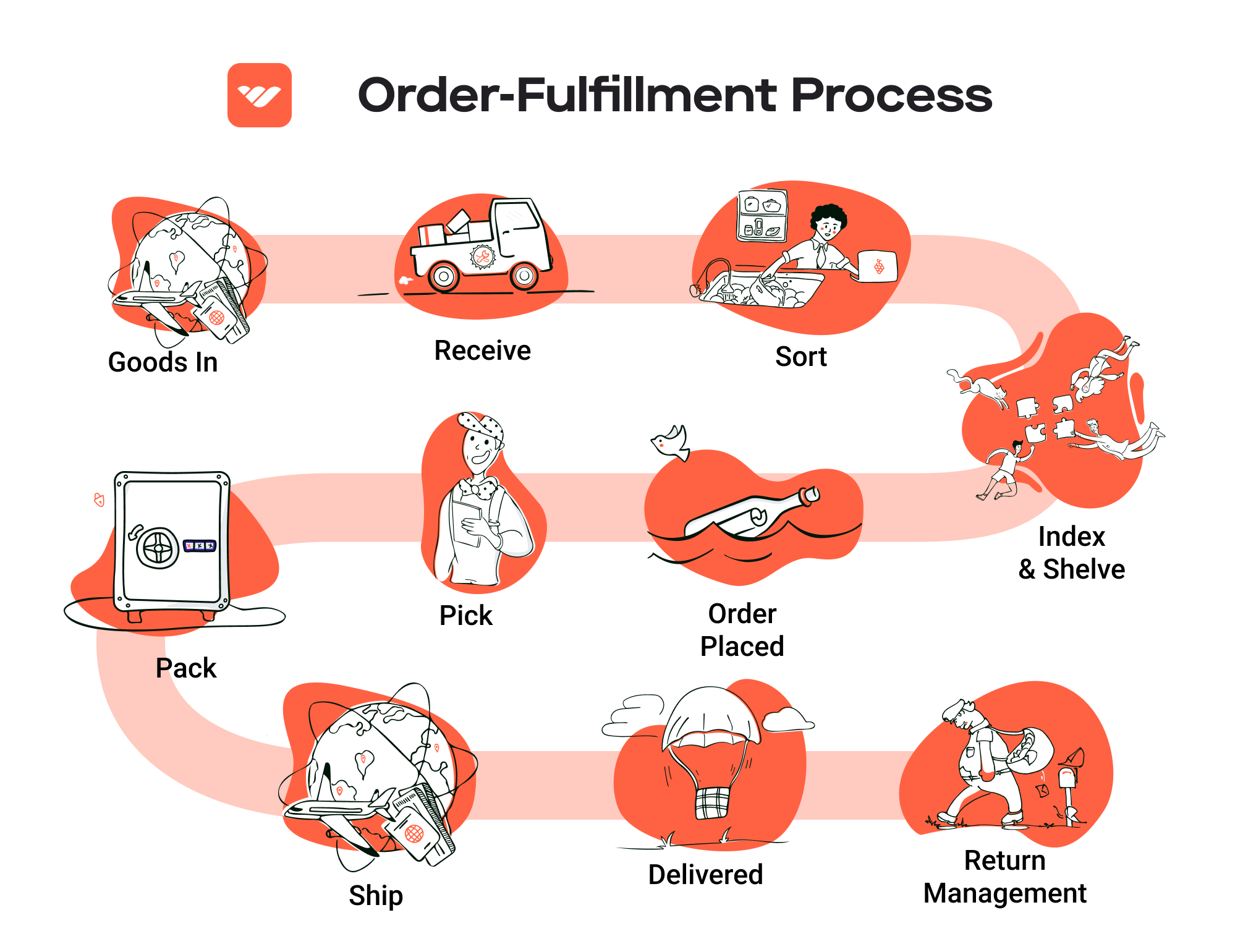
Importance: The efficiency of the picking process significantly impacts the overall fulfillment speed. Quick and accurate picking ensures that customers receive the correct items in a timely manner, fostering customer satisfaction and loyalty. Additionally, utilizing technology such as barcode scanners can enhance accuracy and speed, reducing human error in the fulfillment process.
4. Order Packing
After items are picked, they move to the packing station, where they are packaged for shipment. This step involves selecting appropriate packing materials, ensuring that products are secure and protected during transit. Businesses often use packing slips that accompany the order, detailing the contents and serving as a receipt for customers.
Importance: Proper packing is essential to prevent damage during shipping, which can lead to returns and increased costs. Effective packing practices not only protect products but also enhance the customer’s unboxing experience, which can positively influence future purchasing decisions. Additionally, sustainable packing materials can appeal to environmentally conscious consumers and improve the brand’s reputation.
5. Shipping & Delivery
The final step in the order fulfillment process is shipping and delivery. Once packages are packed, they are labeled and handed over to logistics partners or carriers for delivery to the customer’s address. The shipping process may involve various options, including standard, expedited, or same-day delivery, depending on customer preferences and service availability.
Importance: Shipping speed and reliability are critical factors that influence customer satisfaction. Efficient shipping practices ensure that orders are delivered on time, which is increasingly important in today’s competitive e-commerce landscape. Tracking systems are often employed to provide customers with real-time updates on their order status, enhancing transparency and trust in the business.
In summary, each step of the order fulfillment process, from receiving inventory to shipping and delivery, plays a vital role in ensuring a seamless experience for customers. By optimizing these steps, e-commerce businesses can enhance operational efficiency, improve customer satisfaction, and ultimately scale their operations effectively.
Comparing Fulfillment Models: In-House vs. 3PL vs. Dropshipping
Fulfillment Model Comparison
| Model | Who Handles Inventory | Best For (Business Stage) | Key Advantage | Key Disadvantage |
|---|---|---|---|---|
| In-House Fulfillment | The business itself | Startups to established | Greater control over inventory and processes | High overhead costs and resource demands |
| Third-Party Logistics (3PL) | A third-party provider | Growth-stage businesses | Scalability and expertise in logistics | Less control over inventory and operations |
| Dropshipping | Supplier or manufacturer | Startups and small businesses | Low upfront costs and no inventory risk | Lower profit margins and reliance on suppliers |
In-House Fulfillment
In-house fulfillment involves managing your own inventory and logistics operations. This model is ideal for startups and established businesses that have the resources and capacity to oversee their fulfillment processes directly. By maintaining control over inventory, packaging, and shipping, businesses can tailor their operations to meet specific customer needs, ensuring a consistent brand experience. Additionally, in-house fulfillment allows for better quality control, as businesses can directly manage their inventory and ensure that products meet their standards before reaching customers.
However, the key disadvantage of this model is the high overhead costs associated with warehousing, staffing, and equipment. Businesses need to invest significantly in infrastructure, which can strain cash flow, especially for startups. Furthermore, managing logistics can divert focus from core business activities, such as marketing and product development. As a business scales, the complexities of in-house fulfillment may become overwhelming, necessitating a reevaluation of logistics strategies.
Third-Party Logistics (3PL)
Third-party logistics (3PL) refers to outsourcing fulfillment operations to specialized logistics providers. This model is particularly advantageous for businesses in their growth stage, as it allows them to leverage the expertise and resources of established logistics companies. 3PL providers handle warehousing, inventory management, order processing, and shipping, enabling businesses to scale their operations without the burden of managing logistics internally. This can significantly reduce the time and effort required to fulfill orders, allowing companies to focus on their core competencies.
One of the primary advantages of using a 3PL is scalability; as order volumes increase, businesses can easily adjust their logistics needs without significant capital investment. Additionally, 3PLs often have established networks and relationships with carriers, which can lead to cost savings in shipping and improved delivery times. However, this model also has its drawbacks, primarily related to the loss of control over inventory and fulfillment processes. Businesses must rely on their 3PL partner to maintain quality and efficiency, which can be a risk if the provider does not meet expectations.
Dropshipping
Dropshipping is a fulfillment model where the retailer does not hold inventory but instead relies on suppliers or manufacturers to fulfill orders directly to customers. This model is particularly appealing for startups and small businesses due to its low upfront costs and minimal financial risk. Entrepreneurs can launch their e-commerce stores without the need for substantial investment in inventory, warehousing, or logistics. This flexibility allows them to test various products and markets without the burden of unsold stock.
While dropshipping eliminates the need for inventory management, it also comes with significant disadvantages. One of the most notable is the lower profit margins, as retailers typically pay a premium to suppliers for the convenience of not holding inventory. Additionally, businesses are often at the mercy of their suppliers regarding product availability, shipping times, and quality control. This reliance can lead to inconsistent customer experiences, which may harm a brand’s reputation. Moreover, since many retailers may source from the same suppliers, competition can become fierce, leading to pricing wars and further squeezing profit margins.
Conclusion
Choosing the right fulfillment model is crucial for e-commerce businesses aiming to scale effectively. In-house fulfillment offers control and quality assurance but requires significant investment and resources. Third-party logistics provide scalability and expertise, allowing businesses to focus on growth, although it comes with reduced control. Dropshipping offers a low-risk entry point into e-commerce, but it can limit profit margins and control over customer experience. Each model has its unique advantages and challenges, and the best choice will depend on the specific needs, resources, and growth stage of the business.
A Deep Dive into Amazon FBA: Pros, Cons, and Who It’s For
Understanding Fulfillment by Amazon (FBA)
Fulfillment by Amazon (FBA) is a service offered by Amazon that allows e-commerce sellers to store their products in Amazon’s fulfillment centers. With FBA, sellers can leverage Amazon’s extensive logistics network, allowing them to reach millions of customers through Amazon’s platform. When a customer orders a product, Amazon takes care of storage, packaging, and shipping, as well as customer service and returns. This model not only simplifies the logistics for sellers but also enhances their visibility on the Amazon marketplace.
How FBA Works
-
Product Setup: Sellers create an Amazon seller account and list their products on the Amazon marketplace. They can either create new listings or use existing product listings.
-
Inventory Shipment: Sellers then prepare their products and ship them to Amazon’s fulfillment centers. Amazon has numerous fulfillment centers strategically located to optimize shipping times and costs. For instance, the RIC3 Fulfillment Center located in Richmond, VA, is one of many facilities that help manage logistics for sellers in the region.
-
Storage and Management: Once the products arrive at the fulfillment center, they are stored until sold. Amazon manages inventory levels, ensuring that products are available for customers when needed.
-
Order Fulfillment: When a customer places an order, Amazon picks, packs, and ships the product directly to the customer. This process is typically efficient, allowing for fast delivery, often within two days for Prime members.
-
Customer Service and Returns: Amazon handles all customer inquiries and returns for FBA products, which allows sellers to focus on other aspects of their business, such as marketing and product development.
Pros of Fulfillment by Amazon (FBA)
1. Prime Eligibility
One of the most significant advantages of using FBA is that products become eligible for Amazon Prime. This means that Prime members can receive their orders with expedited shipping, often within two days. This feature not only attracts more customers but also increases the likelihood of higher sales volumes.
2. Customer Trust
Amazon is synonymous with reliability and trust. By using FBA, sellers benefit from Amazon’s reputation. Customers are more likely to purchase items fulfilled by Amazon due to the assurance of quality service, which includes prompt shipping and efficient handling of returns.
3. Multi-Channel Fulfillment
FBA is not limited to sales through the Amazon marketplace. Sellers can also use Amazon’s fulfillment services for sales on their websites or other platforms, allowing for a streamlined logistics solution across multiple sales channels. This flexibility can significantly enhance operational efficiency.
Cons of Fulfillment by Amazon (FBA)
1. High Fees
While FBA offers many benefits, the associated costs can be a significant downside. Sellers incur various fees, including storage fees for keeping inventory in Amazon’s warehouses and fulfillment fees for each order processed. These fees can add up quickly, particularly for slow-moving products, and may eat into profit margins.
2. Strict Inventory Rules
Amazon has specific guidelines regarding inventory management. Sellers must adhere to these rules, including those concerning product condition and packaging. Failure to comply can result in additional fees or even account suspension. This level of control may be restrictive for some sellers, particularly those used to more autonomy in managing their inventory.
3. Commingling Risks
FBA products may be commingled, meaning that inventory from different sellers can be stored together. This can lead to potential issues if a customer receives a product that does not match the seller’s quality standards. If another seller’s product is inferior, it can negatively impact the reputation of all sellers involved, creating a risk that many sellers find concerning.
Who is FBA Best For?
Fulfillment by Amazon is particularly beneficial for small to medium-sized e-commerce businesses that want to scale quickly without the complexities of managing their own logistics. Here are some specific profiles of sellers who may find FBA advantageous:
-
New Sellers: Those just entering the e-commerce space can leverage FBA to tap into Amazon’s vast customer base without needing to invest heavily in logistics infrastructure.
-
Sellers with High Volume: Businesses with high sales volume can benefit from Amazon’s efficient fulfillment network, allowing them to scale operations without the associated headaches of order fulfillment.
-
Businesses Focused on Customer Experience: Sellers who prioritize customer satisfaction and are looking for reliable service options may find FBA aligns well with their business goals, as Amazon handles customer service and returns.
-
Multi-Channel Retailers: E-commerce businesses selling across various platforms can streamline their operations by using FBA for all order fulfillment, simplifying logistics and inventory management.
In conclusion, Fulfillment by Amazon offers a robust solution for many e-commerce businesses looking to streamline logistics, increase sales, and enhance customer trust. However, it’s essential for sellers to carefully evaluate the costs and operational implications of FBA to determine if it aligns with their business goals. Understanding both the pros and cons can lead to more informed decisions, ultimately driving success in the competitive landscape of e-commerce.
Core Services Offered by Fulfillment Centers
Inventory Management & Warehousing
Inventory management and warehousing form the backbone of any successful e-commerce operation. Fulfillment centers like Amazon RIC3 provide a dedicated space for businesses to store their products safely and efficiently. This service includes tracking inventory levels, managing stock replenishment, and ensuring that goods are stored in optimal conditions to prevent damage.
The benefits of effective inventory management are multifaceted. Firstly, it reduces the risk of stockouts, ensuring that popular items are always available for customers, which in turn enhances customer satisfaction and loyalty. Secondly, it minimizes overstock situations, which can lead to increased holding costs and potential markdowns. By leveraging advanced inventory management systems, fulfillment centers can offer real-time visibility into stock levels, enabling e-commerce businesses to make informed decisions about purchasing and production. This not only streamlines operations but also improves cash flow by aligning inventory levels with actual sales trends.
Pick and Pack Services
Pick and pack services are crucial for the order fulfillment process. When a customer places an order, fulfillment centers use efficient picking strategies to retrieve the correct items from inventory. Once picked, these items are packed securely for shipment. This process may seem straightforward, but it involves a high degree of precision and speed.
The primary benefit of pick and pack services is the enhancement of order accuracy and fulfillment speed. In a competitive e-commerce landscape, customers expect rapid delivery and flawless order accuracy. Fulfillment centers utilize technology such as barcode scanning and automated systems to ensure that the right products are picked and packed efficiently. This not only reduces the likelihood of human error but also accelerates the order processing time, allowing businesses to meet or exceed customer expectations for delivery. Additionally, outsourcing these tasks frees up valuable time and resources for e-commerce businesses, enabling them to focus on core activities such as marketing and product development.
Kitting and Assembly
Kitting and assembly services involve combining multiple products into a single package or assembling items before shipping. This service is particularly beneficial for businesses that sell bundled products or require certain items to be put together before they can be sold. For example, a company that sells a DIY furniture kit would benefit from kitting services to ensure all necessary components are packaged together.
The advantages of kitting and assembly services include improved operational efficiency and enhanced customer experience. By pre-packaging items, fulfillment centers help reduce the time required for order fulfillment, leading to faster delivery times. Additionally, these services can create unique product offerings, such as gift sets or promotional bundles, which can attract customers looking for convenience and value. This not only increases the average order value but also encourages repeat purchases as customers appreciate the thoughtful packaging and ease of use.
Returns Management (Reverse Logistics)
Returns management, or reverse logistics, is a critical service offered by fulfillment centers that often goes overlooked. This service encompasses the processes involved in handling returned goods, from the moment a customer initiates a return to the final disposition of the returned items. Fulfillment centers like Amazon RIC3 streamline this process to ensure that returns are handled efficiently and cost-effectively.
The benefits of an effective returns management system are significant for e-commerce businesses. Firstly, it enhances customer satisfaction by providing a hassle-free return process, which can be a deciding factor for customers when making a purchase. A smooth returns experience can lead to increased customer loyalty and positive reviews. Secondly, efficient returns management can help businesses recover value from returned items through refurbishment, resale, or recycling. This not only mitigates losses but can also transform returns into opportunities for additional sales. By leveraging data analytics, fulfillment centers can provide insights into return patterns, enabling businesses to identify product issues and improve quality, thereby reducing future returns.
In conclusion, partnering with a fulfillment center like Amazon RIC3 can provide e-commerce businesses with essential services that enhance operational efficiency, improve customer satisfaction, and ultimately drive growth. By leveraging inventory management, pick and pack services, kitting and assembly, and returns management, businesses can streamline their logistics operations and focus on scaling their sales.
How to Choose a Fulfillment Partner: A 6-Point Checklist
Location & Warehouse Network
Importance: The geographic location of your fulfillment partner’s warehouses significantly impacts shipping times and costs. A partner with strategically placed warehouses can reduce transit times, enhance customer satisfaction, and lower shipping expenses.
Questions to Ask:
– How many warehouses do you operate, and where are they located?
– What is your average shipping time to major metropolitan areas?
– Do you have facilities that cater to international shipping if my business expands globally?
Technology & Integrations
Importance: In today’s e-commerce landscape, technology plays a crucial role in streamlining operations. A fulfillment partner should offer robust technology solutions that integrate seamlessly with your existing systems, such as your e-commerce platform, inventory management, and customer relationship management (CRM) tools.
Questions to Ask:
– What software do you use for inventory management and order processing?
– Can your systems integrate with our current e-commerce platform (e.g., Shopify, WooCommerce, Amazon)?
– Do you offer real-time tracking and reporting capabilities for orders?
Specializations (e.g., Cold Storage, Oversized Items)
Importance: Different businesses have unique fulfillment needs. If your products require special handling, such as temperature control for perishables or additional space for oversized items, it is crucial to partner with a 3PL that specializes in those areas.
Questions to Ask:
– Do you have specialized facilities for cold storage or handling fragile items?
– What experience do you have with my specific product type?
– How do you ensure the quality and safety of products that require special handling?
Scalability & Capacity
Importance: As your business grows, your fulfillment partner must be able to scale operations accordingly. A partner with adequate capacity can handle seasonal spikes in demand or unexpected growth without compromising service quality.
Questions to Ask:
– How do you manage fluctuations in order volume, especially during peak seasons?
– What is your current capacity, and how easily can you expand it if needed?
– Can you provide examples of how you’ve successfully scaled operations for other clients?
Pricing and Contracts
Importance: Understanding the pricing structure and contract terms is essential to avoid unexpected costs and ensure financial sustainability. A transparent pricing model helps you budget effectively and align costs with your business growth.
Questions to Ask:
– What are your pricing models (e.g., per order, monthly fees, storage fees)?
– Are there any additional costs we should be aware of (e.g., for returns, packaging, or special handling)?
– Can you provide a sample contract, and what are the terms for cancellation or service changes?
Customer Support & Reviews
Importance: Excellent customer support is vital for addressing issues promptly and maintaining smooth operations. Additionally, researching a partner’s reputation through reviews can provide insights into their reliability and service quality.
Questions to Ask:
– What level of customer support do you offer (e.g., dedicated account manager, 24/7 support)?
– How do you handle issues or delays in fulfillment, and what is your escalation process?
– Can you provide references or case studies from current or past clients?
Conclusion
Choosing the right fulfillment partner is a critical decision that can significantly impact your e-commerce operations. By carefully evaluating potential partners against this checklist, you can ensure that you select a 3PL that aligns with your business goals and supports your growth strategy. Taking the time to ask the right questions will help you make an informed decision, paving the way for a successful partnership that enhances your customer experience and operational efficiency.
Understanding Fulfillment Pricing: A Breakdown of Common Fees
Initial Setup Fees
When partnering with a fulfillment center like Amazon RIC3, businesses often encounter initial setup fees. These fees are typically one-time charges that cover the costs associated with onboarding your products into the fulfillment system. The setup process may include creating your account, integrating your inventory management systems, and establishing shipping protocols.
The initial setup fee can vary based on the complexity of your product line and the level of customization required for your operations. For instance, if your business has unique packaging requirements or specialized handling instructions, expect higher setup fees. To get a precise estimate, discuss your specific needs with the fulfillment provider during the initial consultation.
Receiving Fees
Receiving fees are charged when your inventory arrives at the fulfillment center. This fee compensates the center for unloading, inspecting, and storing your products. The calculation of receiving fees can depend on several factors, including the volume of inventory and the condition of the products upon arrival.
For example, if you are sending a large shipment, the receiving fee may be calculated per pallet or per unit. Furthermore, if the goods require additional handling or inspection due to discrepancies in the order or damaged items, additional fees may apply. To minimize these fees, ensure your shipments are well-packaged and accurately documented.
Storage Fees (per pallet/bin)
Storage fees are recurring charges based on the amount of space your inventory occupies within the fulfillment center. These fees are typically calculated on a per-pallet or per-bin basis and can vary depending on the duration of storage.
For instance, storage fees may be lower for items stored for shorter periods, while longer storage durations may incur higher monthly fees. Additionally, during peak seasons (such as holidays), storage fees may increase due to higher demand for warehouse space. To manage storage costs effectively, monitor your inventory turnover rates and plan your shipments accordingly to avoid overstocking.
Pick & Pack Fees (per item/order)
Pick and pack fees are incurred each time an order is processed. This fee covers the costs associated with selecting items from the warehouse, packaging them for shipment, and preparing them for delivery. Typically, these fees are charged per item or per order, depending on the fulfillment provider’s pricing structure.
The complexity of the order can also influence the fees; for example, orders that require special packaging or multiple items may incur higher pick and pack fees. To optimize these costs, consider consolidating orders or simplifying your product offerings to streamline the fulfillment process.
Shipping Fees
Shipping fees are one of the most significant costs in the fulfillment pricing model. These fees are calculated based on various factors, including the shipping destination, the weight and dimensions of the package, and the shipping method selected (standard, expedited, etc.).
Fulfillment centers like Amazon RIC3 often have established relationships with carriers, allowing them to negotiate competitive shipping rates. However, it’s essential for businesses to factor in these shipping costs when pricing their products to maintain profitability. To reduce shipping fees, consider strategies such as using regional fulfillment centers for faster, cheaper delivery or implementing a multi-carrier shipping strategy to find the best rates.
Conclusion: Tips for Getting an Accurate Quote
When seeking an accurate quote for fulfillment services, it’s crucial to provide detailed information about your business needs. Here are some practical tips:
- Inventory Details: Clearly outline the types of products you plan to store and ship, including their dimensions and weight.
- Order Volume: Provide estimates of your expected order volume, as many fulfillment centers offer volume discounts.
- Special Requirements: Communicate any specific requirements, such as kitting, labeling, or special handling, that may affect pricing.
- Shipping Preferences: Specify your preferred shipping methods and destinations to receive tailored shipping fee estimates.
- Request Itemized Quotes: Ask for itemized quotes that break down each fee type, allowing you to understand where costs are coming from and identify areas for potential savings.
By following these steps, you can ensure that you receive a comprehensive and accurate quote, helping you make informed decisions as you scale your e-commerce operations.
Frequently Asked Questions (FAQs) about Fulfillment
1. What is the Amazon RIC3 Fulfillment Center?
The Amazon RIC3 Fulfillment Center, located at 4949 Commerce Rd, Richmond, VA, is a state-of-the-art facility designed to store and fulfill customer orders. It plays a critical role in Amazon’s logistics network, ensuring fast and efficient delivery of a vast selection of products.
2. How does the fulfillment process work at the RIC3 center?
At the RIC3 Fulfillment Center, products are received, stored, picked, packed, and shipped to customers. Orders are processed through advanced inventory management systems and automated technologies, allowing for quick turnaround times and high accuracy in order fulfillment.
3. What are the operating hours of the Amazon RIC3 Fulfillment Center?
The Amazon RIC3 Fulfillment Center operates 24/7, meaning it is open every day of the week, including weekends and holidays. This continuous operation allows for efficient handling of orders and inventory.
4. What is the difference between a warehouse and a fulfillment center?
A warehouse primarily focuses on the storage of goods, often for long-term holding, while a fulfillment center is specifically designed to manage the entire order fulfillment process. This includes receiving orders, picking products, packing them, and shipping them to customers, often with a focus on speed and efficiency.
5. What is a Third-Party Logistics Provider (3PL)?
A Third-Party Logistics Provider (3PL) is a service that allows businesses to outsource their logistics and supply chain management. This can include warehousing, transportation, and fulfillment services. Partnering with a 3PL can help businesses scale operations without the need for significant investment in logistics infrastructure.
6. How much do fulfillment services cost?
Fulfillment service costs can vary widely based on several factors, including order volume, storage space needed, and specific services required (like packaging and shipping). Generally, costs can range from $2 to $10 per order, plus storage fees, which may be charged monthly based on the amount of space your products occupy in the fulfillment center.
7. What types of products can be fulfilled through the RIC3 center?
The Amazon RIC3 Fulfillment Center handles a wide range of products, including electronics, clothing, beauty products, home goods, and more. It serves as a hub for both everyday essentials and specialized items, catering to diverse customer needs.
8. How does Amazon ensure the accuracy of order fulfillment at the RIC3 center?
Amazon employs advanced technologies, including barcode scanning, machine learning algorithms, and automated sorting systems, to ensure accuracy in order picking and packing. Additionally, staff are trained in best practices for inventory management to minimize errors.
9. What are the benefits of using Amazon’s fulfillment services for small businesses?
Utilizing Amazon’s fulfillment services allows small businesses to leverage Amazon’s extensive logistics network, ensuring faster shipping times and access to Amazon Prime customers. This can enhance customer satisfaction and potentially increase sales without the need for significant investment in logistics infrastructure.
10. How can businesses start using the Amazon RIC3 Fulfillment Center for their products?
Businesses interested in utilizing the Amazon RIC3 Fulfillment Center should consider enrolling in the Fulfillment by Amazon (FBA) program. This involves creating an Amazon seller account, listing products, and shipping inventory to the fulfillment center. Amazon will then handle the storage, picking, packing, and shipping of orders on behalf of the seller.
Conclusion: Is Outsourcing Fulfillment the Right Move for Your Business?
Evaluating the Benefits of Outsourcing Fulfillment
Outsourcing fulfillment can be a transformative strategy for e-commerce businesses seeking to scale efficiently. By partnering with a fulfillment service, you can save significant time and resources that would otherwise be spent on managing logistics, inventory, and shipping processes. This time savings allows you to focus on core business activities, such as marketing, product development, and customer engagement, which are crucial for growth.
One of the standout advantages of utilizing a fulfillment service is scalability. As your business experiences fluctuations in demand, a reliable partner can easily adjust to meet your needs, whether it’s ramping up operations during peak seasons or scaling down during quieter periods. This flexibility ensures that you can maintain high levels of customer satisfaction without the burden of managing excess inventory or workforce.
Moreover, fulfillment centers like Amazon RIC3 bring a wealth of expertise to the table. They are equipped with advanced technology and seasoned professionals who understand the nuances of logistics and supply chain management. This expertise can enhance your operational efficiency and reduce errors, ultimately leading to faster delivery times and improved customer experiences.
However, choosing the right fulfillment partner is critical to your success. Not all providers offer the same level of service, and aligning their capabilities with your business goals is essential for sustainable growth.
Call to Action
To determine if outsourcing fulfillment is the right move for your business, take a moment to audit your current shipping processes. Assess your pain points, costs, and the time dedicated to logistics. This evaluation will help you identify whether partnering with a fulfillment service could streamline your operations and support your growth objectives. If you find areas for improvement, consider reaching out to potential partners to explore how they can help elevate your e-commerce strategy.
Important Disclaimer
⚠️ Important Disclaimer
The information in this guide is for educational purposes. Fulfillment services, pricing, and platform features change frequently. Always conduct your own due diligence and consult with providers directly before making business decisions.
